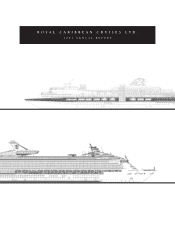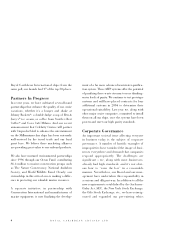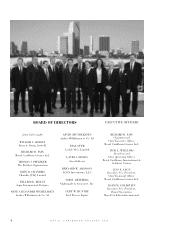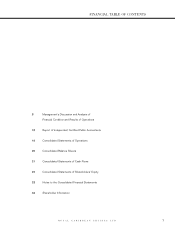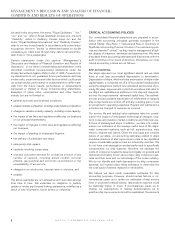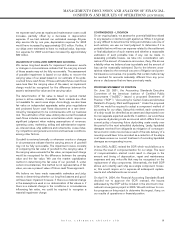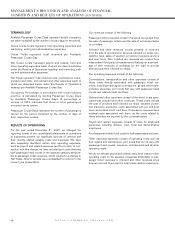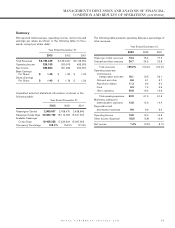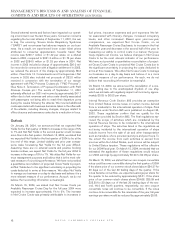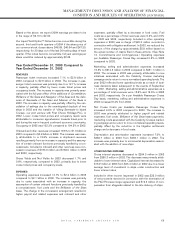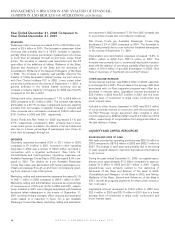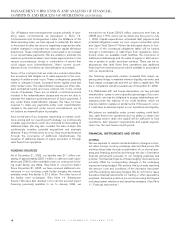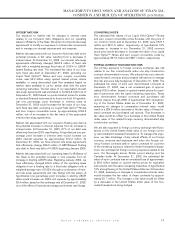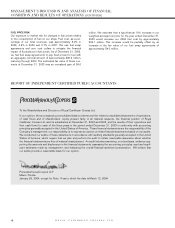Royal Caribbean Cruise Lines 2003 Annual Report Download - page 11
Download and view the complete annual report
Please find page 11 of the 2003 Royal Caribbean Cruise Lines annual report below. You can navigate through the pages in the report by either clicking on the pages listed below, or by using the keyword search tool below to find specific information within the annual report.
we expense each year as repairs and maintenance costs could
increase, partially offset by a decrease in depreciation
expense. If we had reduced our estimated average 30-year
ship service life by one year, depreciation expense for 2003
would have increased by approximately $10 million. Further, if
our ships were estimated to have no residual value, deprecia-
tion expense for 2003 would have increased by approximately
$60 million.
VALUATION OF LONG-LIVED ASSETS AND GOODWILL
We review long-lived assets for impairment whenever events
or changes in circumstances indicate that the carrying amount
of these assets may not be fully recoverable. The assessment
of possible impairment is based on our ability to recover the
carrying value of our asset based on our estimate of its undis-
counted future cash flows. If these estimated future cash flows
were less than the carrying value of the asset, an impairment
charge would be recognized for the difference between the
asset’s estimated fair value and its carrying value.
The determination of fair value is based on quoted market
prices in active markets, if available. Such markets are often
not available for used cruise ships. Accordingly, we also base
fair value on independent appraisals, sales price negotiations
and projected future cash flows discounted at a rate deter-
mined by management to be commensurate with our business
risk. The estimation of fair value utilizing discounted forecasted
cash flows includes numerous uncertainties which require our
significant judgment when making assumptions of revenues,
operating costs, marketing, selling and administrative expens-
es, interest rates, ship additions and retirements, cruise indus-
try competition and general economic and business conditions,
among other factors.
Goodwill is reviewed annually or whenever events or changes
in circumstances indicate that the carrying amount of goodwill
may not be fully recoverable. The impairment review consists
of comparing the fair value of goodwill to the carrying value. If
the carrying value exceeds the fair value, an impairment charge
would be recognized for the difference between the carrying
value and the fair value. We use the market capitalization
method in determining the fair value of our goodwill. If, under
certain circumstances, this method is not representative of fair
value, we use a present value of future cash flows approach.
We believe we have made reasonable estimates and judg-
ments in determining whether our long-lived assets and good-
will have been impaired; however, if there is a material change
in the assumptions used in our determination of fair values or if
there is a material change in the conditions or circumstances
influencing fair value, we could be required to recognize a
material impairment charge.
CONTINGENCIES – LITIGATION
On an ongoing basis, we assess the potential liabilities related
to any lawsuits or claims brought against us. While it is typical-
ly very difficult to determine the timing and ultimate outcome of
such actions, we use our best judgment to determine if it is
probable that we will incur an expense related to the settlement
or final adjudication of such matters and whether a reasonable
estimation of such probable loss, if any, can be made. In
assessing probable losses, we take into consideration esti-
mates of the amount of insurance recoveries, if any. We accrue
a liability when we believe a loss is probable and the amount of
loss can be reasonably estimated. Due to the inherent uncer-
tainties related to the eventual outcome of litigation and poten-
tial insurance recoveries, it is possible that certain matters may
be resolved for amounts materially different from any provi-
sions or disclosures that we have previously made.
PROPOSED STATEMENT OF POSITION
On June 29, 2001, the Accounting Standards Executive
Committee of the American Institute of Certified Public
Accountants (“AcSEC”) issued a proposed Statement of
Position (“SOP”), “Accounting for Certain Costs and Activities
Related to Property, Plant and Equipment.” Under the proposed
SOP, we would be required to adopt a component method of
accounting for our ships. Using this method, each component
of a ship would be identified as an asset and depreciated over
its own separate expected useful life. In addition, we would have
to expense drydocking costs as incurred which differs from our
current policy of accruing future drydocking costs evenly over
the period to the next scheduled drydocking. Lastly, liquidated
damages received from shipyards as mitigation of consequen-
tial economic costs incurred as a result of the late delivery of a
new ship would have to be recorded as a reduction of the ship’s
cost basis versus our current treatment of recording liquidated
damages as nonoperating income.
In late 2003, AcSEC revised the SOP, which would allow us to
choose the level of componentization for our ships. The level
of componentization elected could result in changes in the
amount and timing of depreciation, repair and maintenance
expenses and any write-offs that may be recognized on the
replacement of ship components. Alternatively, the draft SOP
allows us to identify each ship as a single component; howev-
er, this would require us to expense all subsequent replace-
ments and refurbishments as incurred.
On April 14, 2004, the Financial Accounting Standards Board
decided not to approve the SOP; instead, the issues
addressed by the SOP will be included in the short-term inter-
national convergence project in 2005. We will continue to mon-
itor progress on this project to determine the impact, if any, on
our results of operations or financial position.
ROYAL CARIBBEAN CRUISES LTD. 9
MANAGEMENT’S DISCUSSION AND ANALYSIS OF FINANCIAL
CONDITION AND RESULTS OF OPERATIONS (CONTINUED)

